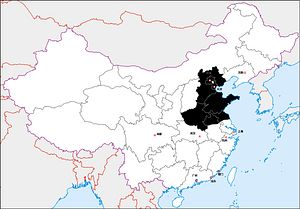This article series explores 12 distinct “regions” within China: six “core” regions long dominated by the majority Han ethnic group and six “periphery” regions home to many of China’s ethnic minorities. The series overview is available here. To view the full series, click here.
The heartland of ancient China, this alluvial plain stretches from the Taihang mountains in the west to the Bohai Gulf in the east, and from the Yan mountains north of Beijing to the Huai River watershed in the south. One of the world’s cradles of civilization, it was both nurtured and cursed by the silt-laden Yellow River, which enabled intensive dry-land agriculture; wet rice cultivation came to typify “China” only in later times, with the southward march of Han settlement.
Excepting Xi’an, all the long-term capitals of a united China have been located here. These political centers maintained their dominance over two millennia as China’s economic center of gravity shifted southwards, by tapping the wealth of the Yangtze delta through the world’s longest canal system, which is now being incorporated into China’s mammoth south-north water transfer project.
Today, the North China plain remains the country’s most populous region, but there are stark disparities between coast and interior. The inland economy is weighted toward agriculture and overcapacity-plagued heavy industries, and suffers from chronic pollution, underemployment and poverty.
The landlocked province of Henan is the epicenter of China’s HIV/AIDS epidemic and its 94 million inhabitants are stereotyped around the nation as migrant criminals. This region is also ground zero for China’s water crisis, with the water table dropping by around a meter each year, and an estimated 70 percent of groundwater too polluted for human contact.
Beijing, however, is the second richest city in China (after Shanghai), the seat of central government, and host to the largest concentration of the nation’s top universities. These advantages have made it the hub of China’s booming tech sector and R&D complex, and of a planned conurbation that if realized will be six times the size of New York, including a new city being built from scratch to relieve population pressure on the capital. Also growing fast are the port cities of Tianjin and Qingdao, the former in the process of building a model eco-city in collaboration with Singapore, and the latter hosting two of China’s leading homegrown exporters, the whitegoods and electronics makers Haier and Hisense.
Located at the southern entrance to the Bohai Gulf that separates China from Korea, Qingdao is also the headquarters of the People’s Liberation Army (PLA) North Sea Fleet and home port of China’s first aircraft carrier, the Liaoning. Among the five PLA theater commands established in 2016, the Central Theater Command headquartered in Beijing has the largest number of assigned troops, reflecting an old Chinese tradition of massing soldiers around the capital. These forces are likely to be treated as the PLA’s strategic reserve. One report holds that authority over the North Sea Fleet has been given to the Central Theater Command, in view of 19th century attacks on Beijing having come across the Bohai Gulf.
Next up: China’s loess plateau.
John Lee is a former visiting fellow of the Mercator Institute for China Studies. He tweets at @J_B_C16.

































